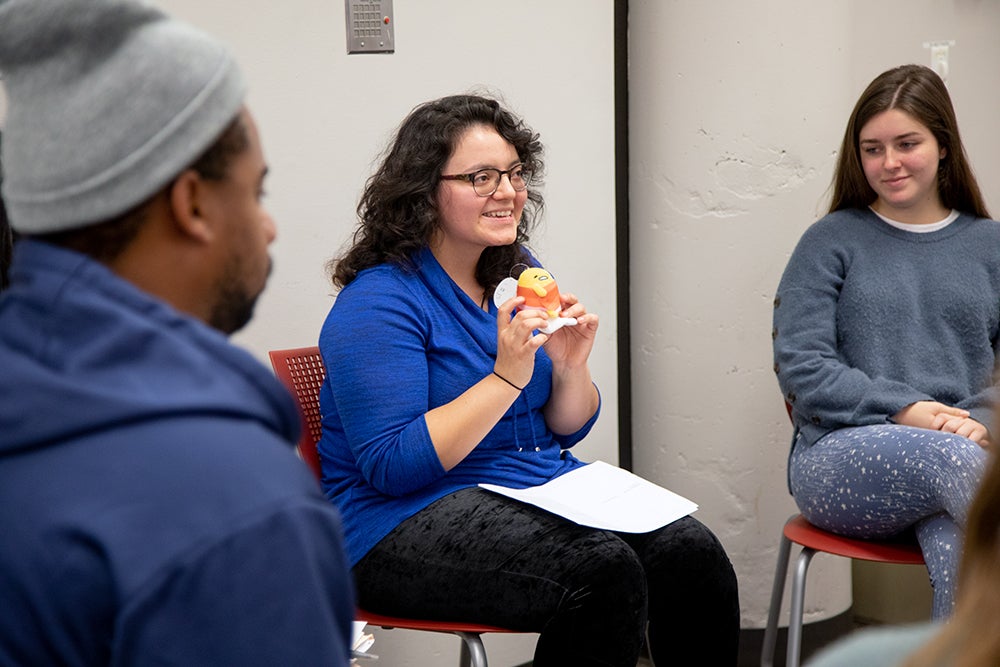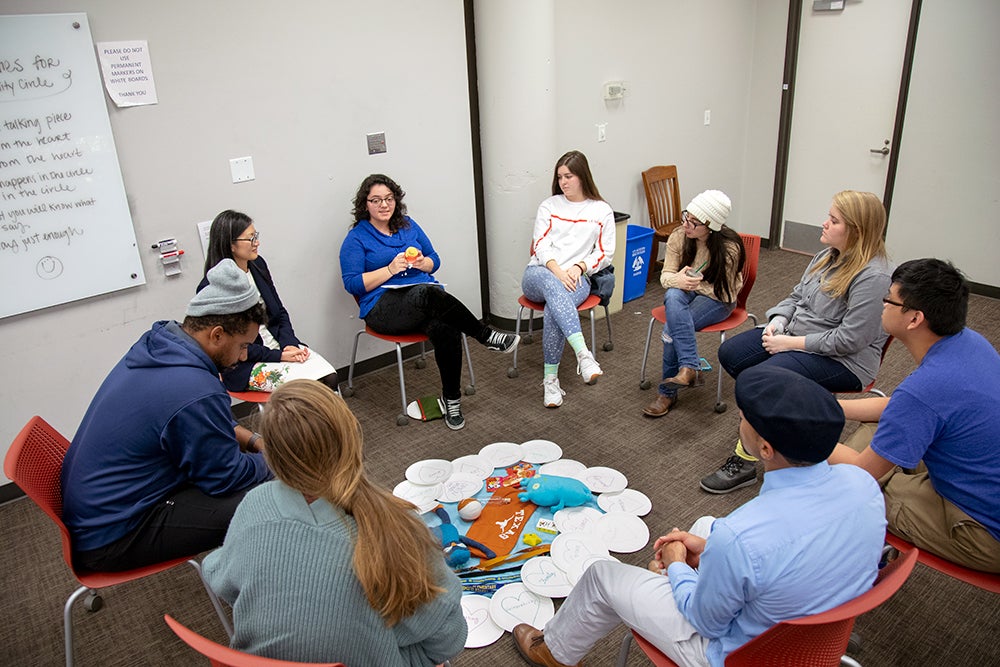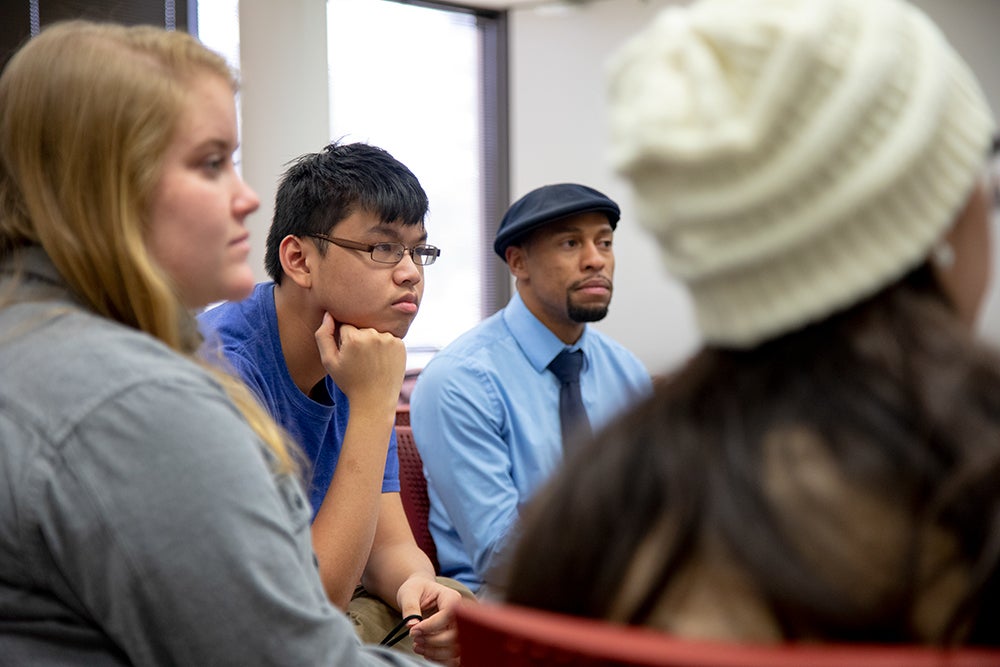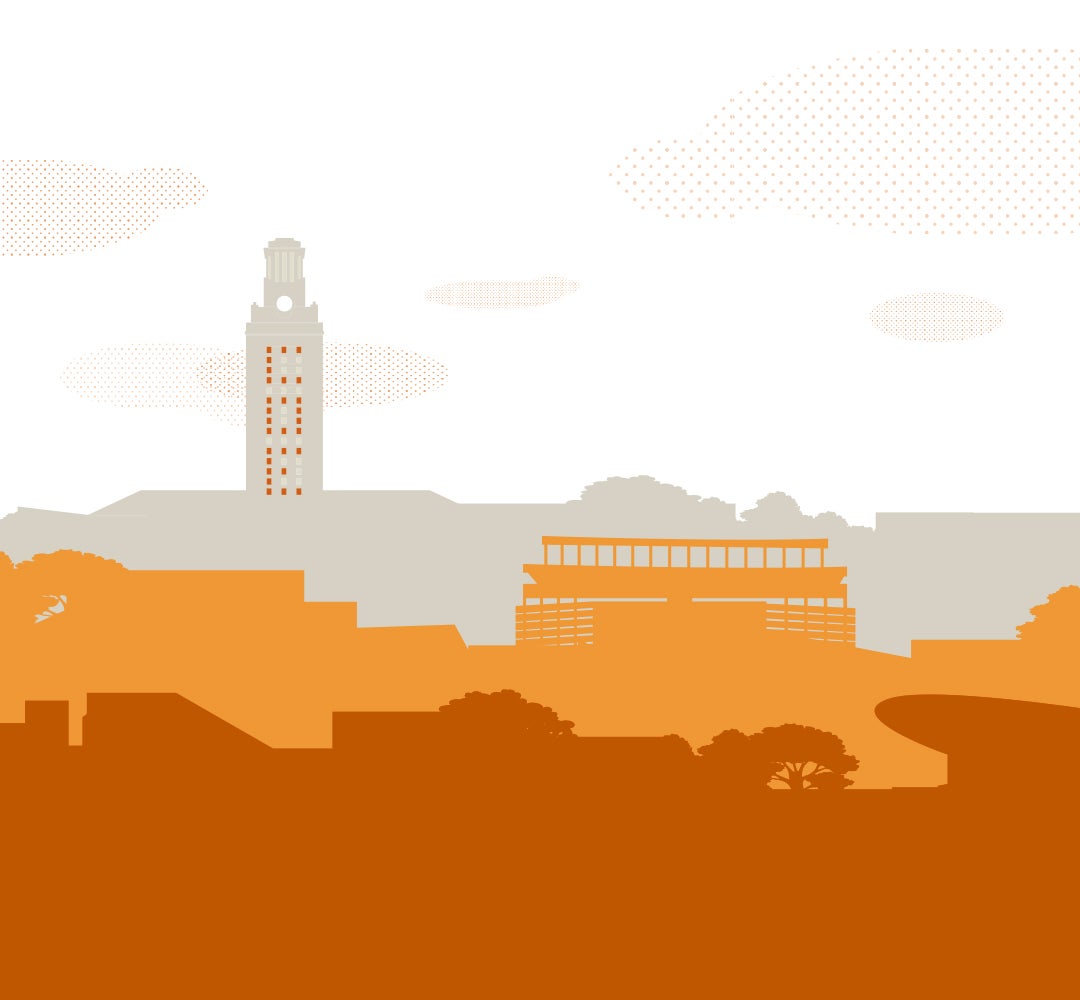Eight UT Austin undergraduates and their instructor are sitting in a circle in a classroom. Taryn, the day’s facilitator, introduces the guidelines: “Respect the talking piece, speak from the heart, listen from the heart, what happens in the circle stays in the circle, trust you will know what to say, say just enough.”
 She placed each students’ values, like ‘courage,’ ‘trust,’ and ‘open-mindedness’ around the circle’s center-piece. She explains to the group that the talking piece, a stuffed animal, will signal who has the floor to speak. She chooses one of the values and explains why she honors it. She passes the talking piece to Sofia, who chooses the value of compassion, and on it goes before they start their next round.
She placed each students’ values, like ‘courage,’ ‘trust,’ and ‘open-mindedness’ around the circle’s center-piece. She explains to the group that the talking piece, a stuffed animal, will signal who has the floor to speak. She chooses one of the values and explains why she honors it. She passes the talking piece to Sofia, who chooses the value of compassion, and on it goes before they start their next round.
The circle is an everyday part of the Restorative Practices in Education class that Assistant Professor of Practice Molly Trinh Wiebe teaches. It’s an education course within the Department of Curriculum and Instruction in the College of Education, cross-listed with Steve Hicks School of Social Work, and open to any undergraduate and graduate on campus. The majority of students are education majors, but some, like Nicole and Norman, are majoring in subjects such as government and sociology.
According to Wiebe, the course highlights restorative practices’ roots and principles as they can be applied to schools and the larger community. The principles learned emphasize responsibility, accountability, respect, and restoration, and students learn how to facilitate restorative circles to build relationship and trust with youths, parents, peers, and the community.
Though Sofia had never heard of restorative practices or restorative circles before, she said she was encouraged to take the class by her aunt, who is a teacher in Austin. “I’d never really thought of something like this as an option in education,” she says.
D’Jon says the practices are similar to the circles he experienced as huddles on wrestling and basketball teams in high school, though they weren’t named as such. He later recognized similar practices when he was doing prison ministry. “We had 42 residents and six tables and we’d form a circle and get to know each other at the table and check in on each other. The practices teach us to value the whole person.”
The circle plays a comparable community-building role in this classroom. Says Wiebe, “When a student is absent, we all care to know that they are alright. We all know each other’s names and a bit of history about each other. We have built a relationship and trust among us. This is our community and we look out for each other.”
Restorative Practices’ Indigenous Roots
According to Wiebe, restorative practices are rooted in indigenous traditions. Modern communities have used them in the criminal justice system to support individuals who have made the offense repair the harm that was done.
The practices also have been used to support those who were incarcerated reintegrate into society. Typically, those practices are called restorative justice. Within school systems they are called restorative practice so that students don’t feel penalized. “Restorative practice can play a role in disrupting the school-to-prison pipeline phenomenon, which zero-tolerance policies can serve to actively perpetuate,” says Wiebe. “Restorative practice is a humanizing approach toward education.”
Beyond Classroom Circles Toward Educational Policy and Practice
Joshua Childs, an assistant professor in Educational Leadership and Policy, adds that all spaces have the potential to be restorative spaces. “Beyond the classroom, the spaces students find as they walk to school and are out in the community can be restorative,” says Childs. He adds that such practices are a two-fold process. “Though it’s often focused on what’s happening with students, the adults or educators also have to be part of the restorative practice element. They should be considering how their practice as educators may be contributing to the school community and to trust.”
“Adults have to shift their practice so that they aren’t always leading with something punitive,” says Childs. “Schools can take into account what’s happening in students’ lives—such as their home life, their walk or commute to school, their physical and mental wellness—and look at how school policy adapts to that. When they institute nonpunitive dress codes and decriminalize attendance, they are using restorative practices rather than punitive, deficit practices,” says Childs. (For more on how school policy can interrupt cycles of chronic absenteeism, see Childs’ Discovery Minute.)
 Norman, a student in Wiebe’s restorative circle, agrees. “Whenever a student is doing something that is against school rules, it usually means something is preventing them from doing so. It’s possible that something happened in their family or they got into an accident. There’s always a reason why.”
Norman, a student in Wiebe’s restorative circle, agrees. “Whenever a student is doing something that is against school rules, it usually means something is preventing them from doing so. It’s possible that something happened in their family or they got into an accident. There’s always a reason why.”
He adds that restorative practices don’t have to be complex. There are simple things educators can do. “A teacher can allow two to three absences because they understand that life happens. They can give out tokens to use for deadline extensions or revise essays,” says Norman. “Restorative practices build flexibility.”

